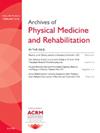Preliminary Evidence of the Prevalence of Pelvic Floor Disorders in Veterans with Major Lower Limb Amputation 1139
IF 3.6
2区 医学
Q1 REHABILITATION
Archives of physical medicine and rehabilitation
Pub Date : 2025-04-01
DOI:10.1016/j.apmr.2025.01.047
引用次数: 0
Abstract
Objectives
To provide evidence of the magnitude and impact of pelvic floor disorders in people with lower limb amputation (LLA). To examine associations between the pelvic floor disorders, low back pain, and prosthetic mobility.
Design
Cross-sectional, national survey-based study of male and female Veterans with LLA. Because of limitations in the number of female Veterans with LLA, women were oversampled. Additionally, Veterans of color (ie, non-White race, Hispanic ethnicity) and those under 60 years old were also oversampled.
Setting
Utilization of the Veterans Affairs Computer Data Warehouse to identify potential study participants. Study was completed from the participants personal environment.
Participants
Eighty-five male and female veterans with unilateral LLA who had been issued a prosthetic leg completed the study. Inclusion criteria: unilateral LLA at the transtibial level or higher, use of a prosthetic leg for >6 months for daily mobility, English literate. Exclusion criteria: bilateral LLA any level above toes, significant cognitive deficit.
Interventions
None.
Main Outcome Measures
Pelvic Floor Disability Index-20 (PFDI-20) assessed distress related to PFD symptoms. Prosthetic Limb Users Survey of Mobility assessed perceived prosthetic mobility. Oswestry Disability Index assessed disability related to low back pain.
Results
Scores on the PFDI-20 indicate that 98% of study participants are reporting some level of PFD symptoms. Mean age of participants was 51.1 (13.6) years, mean time since amputation was 15.2 (20.7) years. Study sample consisted of 54% females, 40% of participants reported being Veterans of color. Seventy-one percent of participants were under 60 years old. Examining results by sex, 61.5% of males and 60.9% of females reported mild distress related to PFD symptoms, 35.9% of males and 32.6% of females reported moderate distress, 2.6% of males and 2.2% of females reported severe distress. Notably, 4.4% of females, and no male participants, reported no distress from symptoms. Seventy-five percent of participants reported being treated for low back pain in the past. Moderate correlations were observed between PFDI-20 scores and scores on the Oswestry Disability Index (r=0.56, P<.01) and the Prosthetic Limb Users Survey of Mobility (r=−0.51, P>.01).
Conclusions
This is the first study to report on the occurrence of PFDs in the LLA population. Results indicate that a significant number of nonelderly male and female Veterans with major LLA are experiencing some level of distress related to PFDs. Undetected PFDs may be influencing low back pain and mobility deficits in this population. Further investigation is warranted to explore the impact of PFD symptoms on quality of life.
Supported by the Veterans Affairs.
Disclosures
none.
求助全文
约1分钟内获得全文
求助全文
来源期刊
CiteScore
6.20
自引率
4.70%
发文量
495
审稿时长
38 days
期刊介绍:
The Archives of Physical Medicine and Rehabilitation publishes original, peer-reviewed research and clinical reports on important trends and developments in physical medicine and rehabilitation and related fields. This international journal brings researchers and clinicians authoritative information on the therapeutic utilization of physical, behavioral and pharmaceutical agents in providing comprehensive care for individuals with chronic illness and disabilities.
Archives began publication in 1920, publishes monthly, and is the official journal of the American Congress of Rehabilitation Medicine. Its papers are cited more often than any other rehabilitation journal.

 求助内容:
求助内容: 应助结果提醒方式:
应助结果提醒方式:


